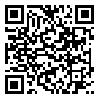Volume 17, Issue 5 (12-2023)
payavard 2023, 17(5): 434-445 |
Back to browse issues page
Ethics code: IR.MAZUMS.REC.1401.243
Download citation:
BibTeX | RIS | EndNote | Medlars | ProCite | Reference Manager | RefWorks
Send citation to:



BibTeX | RIS | EndNote | Medlars | ProCite | Reference Manager | RefWorks
Send citation to:
Barzegari S, Ghazi Saeedi M, Nazari R, Mahdavi S A, Hasani S A. Psychometric Properties of Persian Version of the Mobile-Health Technology Engagement Index. payavard 2023; 17 (5) :434-445
URL: http://payavard.tums.ac.ir/article-1-7519-en.html
URL: http://payavard.tums.ac.ir/article-1-7519-en.html
Saeed Barzegari1 
 , Marjan Ghazi Saeedi2
, Marjan Ghazi Saeedi2 
 , Roghieh Nazari3
, Roghieh Nazari3 
 , Seif Ali Mahdavi4
, Seif Ali Mahdavi4 
 , Seyed Alireza Hasani *
, Seyed Alireza Hasani * 
 3
3

 , Marjan Ghazi Saeedi2
, Marjan Ghazi Saeedi2 
 , Roghieh Nazari3
, Roghieh Nazari3 
 , Seif Ali Mahdavi4
, Seif Ali Mahdavi4 
 , Seyed Alireza Hasani *
, Seyed Alireza Hasani * 
 3
3
1- Assistant Professor, Department of Paramedicine, Amol School of Paramedical Sciences, Mazandaran University of Medical Sciences, Sari, Iran
2- Professor, Department of Health Information Management and Medical Informatics, School of Allied Medical Sciences, Tehran University of Medical Sciences, Tehran, Iran
3- Assistant Professor, Department of Nursing, Amol School of Nursing and Midwifery, Mazandaran University of Medical Sciences, Sari, Iran
4- Associate Professor, Department of Paramedicine, Amol School of Paramedical Sciences, Mazandaran University of Medical Sciences, Sari, Iran
2- Professor, Department of Health Information Management and Medical Informatics, School of Allied Medical Sciences, Tehran University of Medical Sciences, Tehran, Iran
3- Assistant Professor, Department of Nursing, Amol School of Nursing and Midwifery, Mazandaran University of Medical Sciences, Sari, Iran
4- Associate Professor, Department of Paramedicine, Amol School of Paramedical Sciences, Mazandaran University of Medical Sciences, Sari, Iran
Abstract: (561 Views)
Background and Aim: The use of Mobile-Health is helpful in facilitating therapeutic communication between students and healthcare providers. Considering the benefits of the Mobile-Health, it is very important to have a tool that can check the motivation to use Mobile-Health. Therefore, this study was conducted with the aim of Psychometric properties of mHealth Technology Engagement Index.
Materials and Methods: The present study is psychometric research that was conducted in Tehran University of Medical Sciences in 1401. The participants of this study were 450 students of medical sciences in Tehran in undergraduate, master’s and doctorate levels who were included in the study through convenience sampling. The psychometric characteristics of the questionnaire were examined through face, content and construct validity respectively. Principal component analysis was performed using varimax rotation in order to check the factorial structure of the questionnaire. The reliability of the questionnaire was checked with the help of Cronbach’s alpha and intra- class correlation (ICC).
Results: The questionnaire’s content validity ratio (CVR) and content validity index (CVI) were 0.91 and 0.86, respectively. In the formal validity check, minor changes were made in the words of most of the items. Based on the results of face validity, some minor changes were made to the vocabulary of most items. The ICC coefficient was more than 0.80 in all dimensions. The results of exploratory and confirmatory factor analysis extracted five factors, autonomy, competence, relatedness, goal setting and goal attainment, and their cumulative variance was %71.48. The fit of the five-factor model was optimal based on standard goodness of fit indices such as CFI=0.978, GFI=0.930, RMSEA=0.040, CMIN/DF=1.307. Convergent and divergent validity was accepted for all factors. The reliability of the questionnaire was obtained using Cronbach’s alpha test of 0.71.
Conclusion: The five factor structure of the questionnaire of interaction with mobile health technology has good validity and reliability. Therefore, this questionnaire can be used to check the level of interaction of users of medical science students with mobile health technology.
Materials and Methods: The present study is psychometric research that was conducted in Tehran University of Medical Sciences in 1401. The participants of this study were 450 students of medical sciences in Tehran in undergraduate, master’s and doctorate levels who were included in the study through convenience sampling. The psychometric characteristics of the questionnaire were examined through face, content and construct validity respectively. Principal component analysis was performed using varimax rotation in order to check the factorial structure of the questionnaire. The reliability of the questionnaire was checked with the help of Cronbach’s alpha and intra- class correlation (ICC).
Results: The questionnaire’s content validity ratio (CVR) and content validity index (CVI) were 0.91 and 0.86, respectively. In the formal validity check, minor changes were made in the words of most of the items. Based on the results of face validity, some minor changes were made to the vocabulary of most items. The ICC coefficient was more than 0.80 in all dimensions. The results of exploratory and confirmatory factor analysis extracted five factors, autonomy, competence, relatedness, goal setting and goal attainment, and their cumulative variance was %71.48. The fit of the five-factor model was optimal based on standard goodness of fit indices such as CFI=0.978, GFI=0.930, RMSEA=0.040, CMIN/DF=1.307. Convergent and divergent validity was accepted for all factors. The reliability of the questionnaire was obtained using Cronbach’s alpha test of 0.71.
Conclusion: The five factor structure of the questionnaire of interaction with mobile health technology has good validity and reliability. Therefore, this questionnaire can be used to check the level of interaction of users of medical science students with mobile health technology.
| Rights and permissions | |
 |
This work is licensed under a Creative Commons Attribution-NonCommercial 4.0 International License. |



